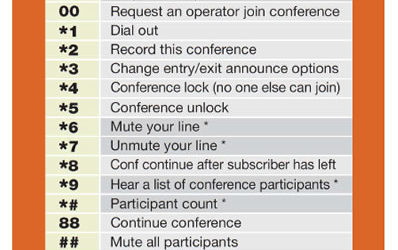#5 Set Ground Rules
All right, let’s get going. We’re going to do this letterman style. Starting at the top, #5, the most effective thing we found that experts suggest, and this is coming from Claire Sookman over in the corporate education group, was to set explicit ground rules. What that means is when you’re having a staff meeting with your department and go over these rules up front and as staff changes. Don’t only talk about them, but get agreement so that everyone can be held accountable.
Some of the rules you may want to consider might be to always have an agenda. That came up a lot and clearly will help facilitate a more effective meeting is there is an agenda. For larger staff meetings, especially if you get into 10, 20, 30 people, you may want to consider even allowing people to come and go for their portion of the call only, which would be identified in that agenda.
Another thing that’s very help, but again should be spelled out in the ground rules, is calling on people by name. Get everyone to answer.
One of the things that we talked about a little bit earlier, and some of the chats had us come in have talked about this, is how to not getting off-track. A suggestion, and it could be established in the ground rule, would be no big monologue. You can set a time limit or a number of sentences or the number of slides. You may say, “No one is going to talk for more than 3 minutes at a time.” Again, with larger calls, it’s often really important to have people always say their name when they’re contributing. “This is Brad. My input on this topic is XYZ.”
#4 Let Them Hear
Let’s go forward to #4. This might seem basic.
There is so many calls where people really cannot hear. They actually can’t hear everyone that’s participating in the call. It’s so important to have people either be required to have or provide for them a headset. What I mean by a headset is something that plugs into their phone. We’re not talking about forcing people onto VoIP and plugging something into their USB port, but rather their phone. This is going to dramatically improve not only the audio quality but it also typically has an impact on having people more engaged in the call itself. Headsets are very inexpensive. If people are attending calls on any regular basis, really important to provide this for them.
This is thanks to Michael Watkins. Something very interesting that maybe not all of have thought about.
#3 Engage & Focus Participants
All right, let’s keep going, number three, engage and focus participants. Now this may seem obvious but we thought there were really some interesting ideas on how to do that provided by Julia Young from facilitate.com. Assign members different responsibilities (scribe, facilitator, etc…). No more than three sliders or 10 minutes before an interactive activity. Buddy up local and remote people. Specifically for a staff meeting where you’re likely having the same people attend each time is to assign them differ roles and different responsibilities, for example maybe rotate who facilitates the call.
If one of your ground rules involves that time, have someone rotate into that position and keep track of how long people are talking. That way you can hold people accountable without it being a personal attack or egregious from anyone. If it rotates hopefully they’re going to be more fair. If you take notes then have that responsibility rotate as well.
Another interesting thing we found was to buddy up local and remote people. So in a staff meeting where you have perhaps half the people at the corporate office and then half the people remote it’s a really interesting and fun way to pair those people up. They can either work and during the call as a team if they’re in the same area functionally within the department, or if it’s assignment roles in a pair, but you can help facilitate a rapport and connection for the people remotely if they’re formally paired up with someone at the corporate office.
Another really good thing is to recognize meetings where not everyone can participate effectively in audio conferences. Some people find it just a little bit difficult because it could be a relatively fast paced conversation. You’ll find this more and more as your culture and company perhaps becomes more global and you’ve got different cultures of people attending a call. People may find it’s difficult to keep up with the conversation from a language perspective, and at the same time be able to formulate their own thoughts into English if that’s the language of choice during the call. It’s recommended to have what would be termed asynchronous tools in addition.
#2 Take Notes
One of the things is to take notes and that was termed minutes on the go and that’s a great way especially for staff meetings. Most Web conferencing tools willl allow you to share a Word document during the call as it’s going on, have whoever’s assigned to that task make notes. Most importantly, make those notes visible to everyone during the call.
It, A, makes sure that there’s no misunderstandings and the notes are complete, and B, it allows you to distribute them immediately after the call if they’re being taken during the call. This can have a real big impact.
#1 Use a Template
All right. Drum roll. Let’s have it for the number one suggestion from our expert panel and that was: Use a template. Again, specifically for staff meeting calls, Jack Shaw recommends that you create a standard presentation that each person contributes to for the staff meeting. It might be three slides or it might be five slides, whatever works for your organization.
Just make sure that everyone is using the same thing because that can have a significant impact on how efficiently you can communicate the information. Get down to the important points of discussion if there are issues that need to be considered or additional information acquired or if there are assignments and to-do actions from that. It will make the preparation for people faster, the updates faster, and the conversation faster. When things are efficient and fast, people stay engaged. If you have questions about audio conferencing, or would like to set up a free trial to test our conferencing solution, visit our free trial page or call 888-55-ADIGO





0 Comments